Nothing in the garden marks the seasonal transition from winter to spring-time quite like the appearance of these cheerful outdoor plants, but knowing when to plant your daffodil bulbs is key, says garden writer Louise Curley.
These easy-to-grow bulbs come back year after year and are available in a huge range of shapes and sizes, varying from tiny, delicate trumpets held on short stems to brash yellow blooms that will awaken your senses after winter. Along with the familiar gold tones, there are pale lemon flowers, pristine white daffodils, and elegant single flowers, alongside some multi-headed varieties and ruffled blooms that resemble frilled petticoats.
Daffodils are some of the most strongly scented plants to be found in the early spring garden. Plant varieties such as ‘Geranium’, which bears striking blooms with vibrant orange centres, ‘Avalanche’ and ‘Cheerfulness’ in pots and gather them together near a window or doorway so that the scent of spring always wafts your way. The buttery-yellow bloom of ‘Chimes’ has a particularly long-lasting scent, while the dwarf ‘Minnow’ variety also has a delightful aroma. You’ll notice that the scent is stronger on a warm day. You can also grow these versatile perennials in a cut flower patch to harvest their blooms for the house.
For a soft meadowy look in your garden, plant low-growing daffodils such as ‘Jenny’ or ‘W.P. Milner’ in your lawn. If you have an area of taller grass, then you can even try a long-stemmed variety such as ‘Pheasant’s Eye’. To create a more natural look, make sure you don’t plant in regimented lines. Instead, scatter the bulbs and then plant them where they fall and avoid cutting the grass until the foliage has died down.
Optimal planting time and preparing for planting
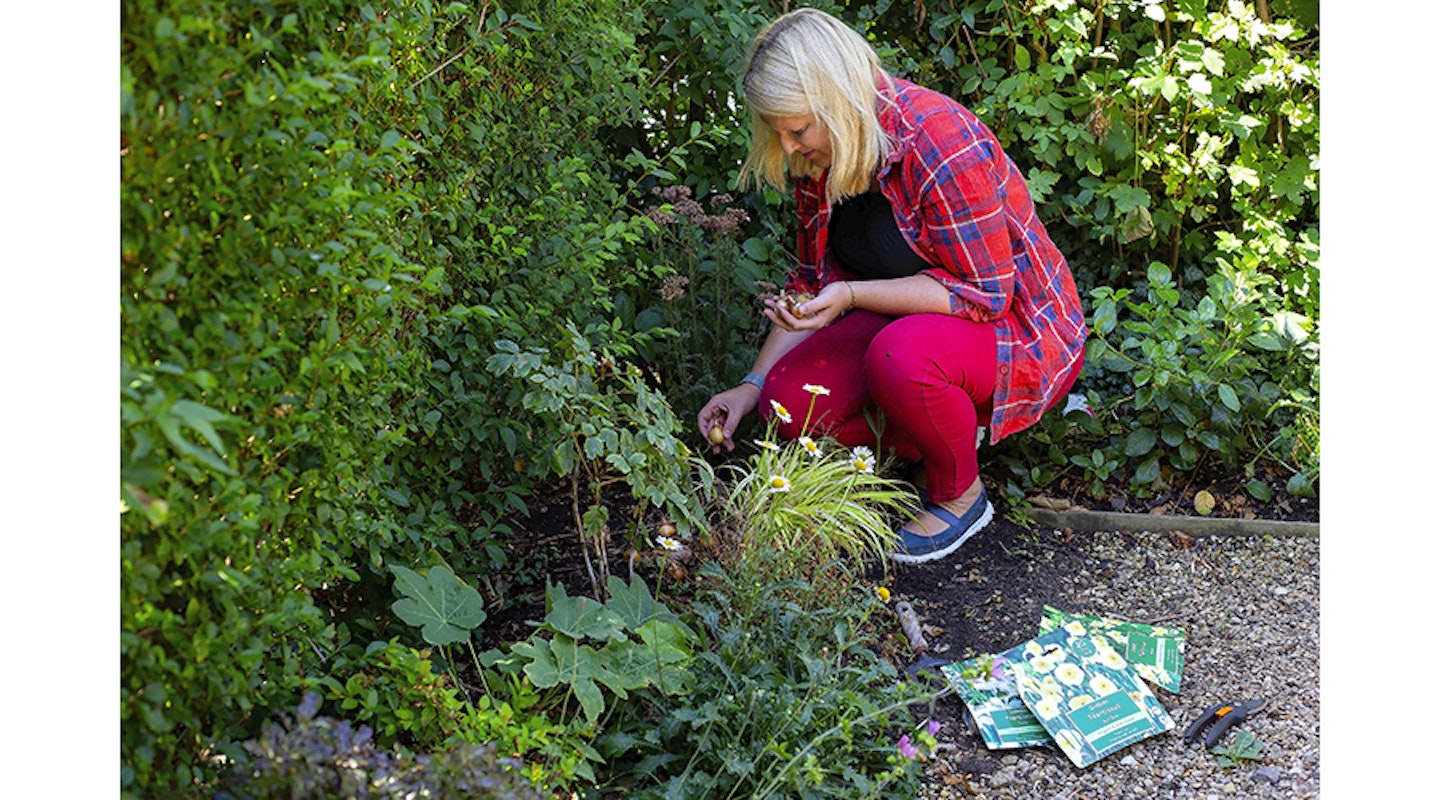
Mid-autumn is the usual time to plant your daffodil bulbs. If you’d like to grow lots of daffodils in a drift in the ground, planting them as bulbs is the thrifty way forward. You’ll also have a greater selection of different types of daffodils to choose from. However, when you’re buying your bulbs from the garden centre in autumn make sure that you choose the largest, firmest bulbs, leaving well alone any that feel soft or that have signs of mould.
Daffodil bulbs need to be planted in October to give them time to start growing before winter sets in. If you buy your bulbs earlier, then make sure that you store them somewhere cool and dark until it’s time for them to be planted.
Planting daffodil bulbs
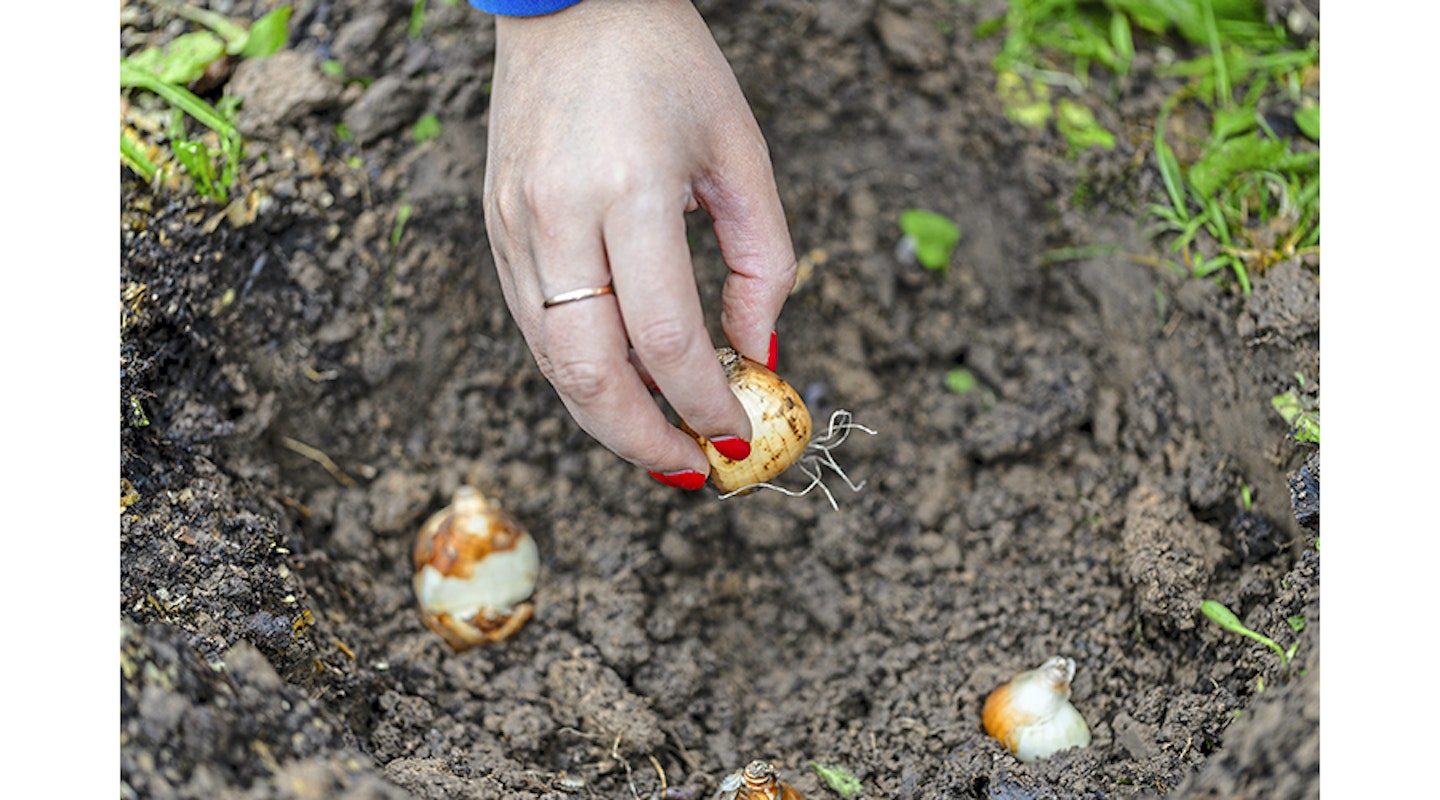
Daffodils can cope with light shade but always perform better in a sunny spot. Plant 3-4 times as deep as the bulb itself with the pointy end facing up, and in groups, with each bulb about 7-10cm away from its nearest companion. The easiest way to make their planting hole, advises garden writer Liz Potter, is to use a long-handled bulb-planting multi-tool, which has a sharp metal cuff to cut the hole and pull out a plug of soil, 12-15cm deep. Add a little grit in heavy soils and plant the bulb with its pointy end uppermost, then bury it.
If you’re naturalising (so they look like they popped up there naturally) the bulbs in lawn grass, use your bulb planting tool to twist out a core of turf, place a little grit and plant fertiliser in the bottom, and place the bulb into the hole before replacing the plug of turf. Or, use a spade to cut the letter ‘H’ in the turf, undercutting the turf and folding it back to reveal a square of bare soil underneath. Loosen the soil with a hand fork and add some bonemeal before planting your bulbs at 12-15cm deep. Replace the turf to cover them and remember not to use a lawn mower on this area until after the daffodils have flowered and faded.
Shorter varieties, with their neater leaves and dainty flowers, are perfectly proportioned for pots and containers. Add some multipurpose soil or compost to the base of your pots, planting your bulbs in October, about 10-15cm deep and 5cm apart. Carefully cover the bulbs with compost to a couple of centimetres below the rim of the pot.
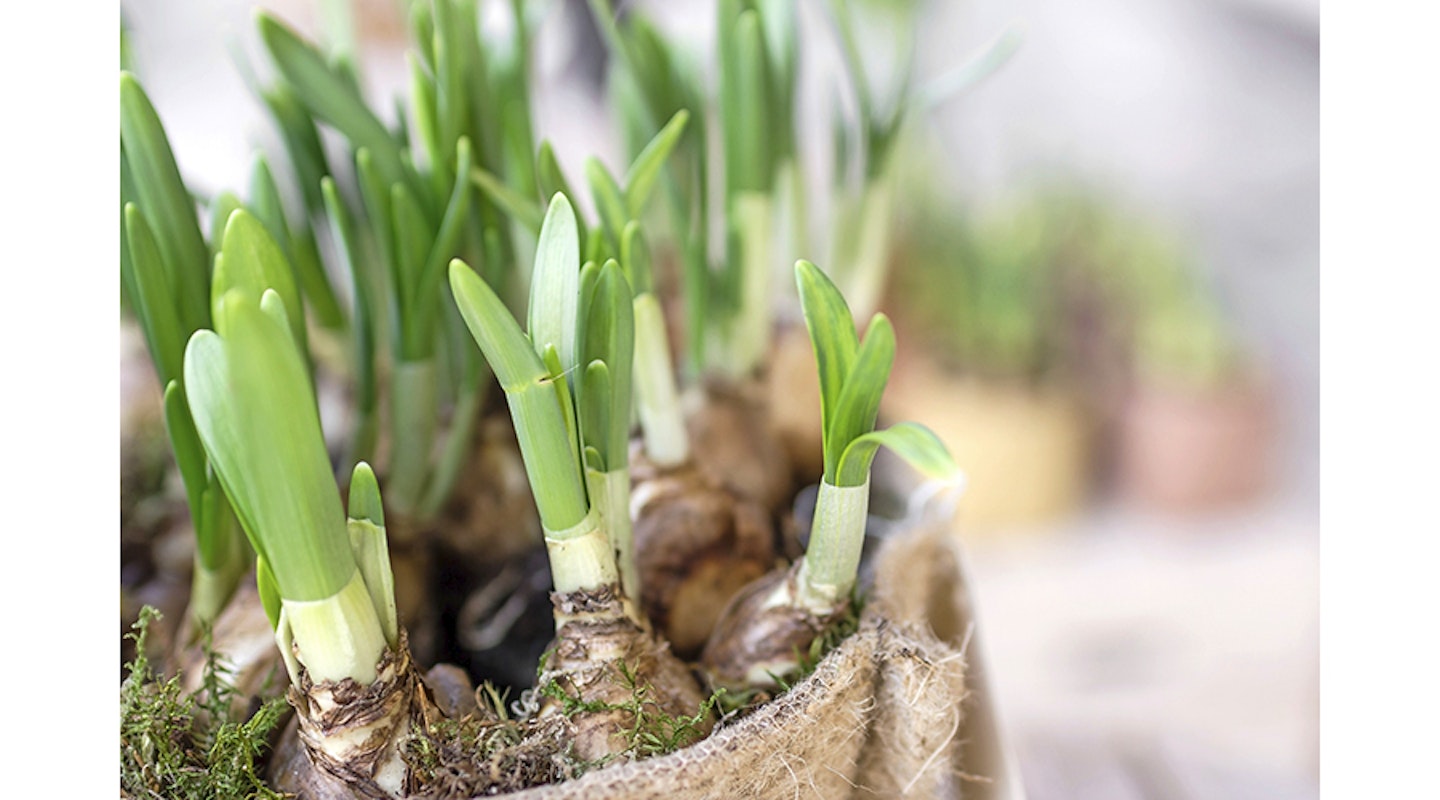
Post-planting care
Given the correct treatment, daffodils will reward you with garden flowers every spring. It’s important that you remove any fading flowers at the top of the stem. This not only makes your garden look a little tidier but it also stops the plant from directing its energy into producing seeds. Instead, you want it to focus on building a strong bulb underground to produce a good show of flowers next year.
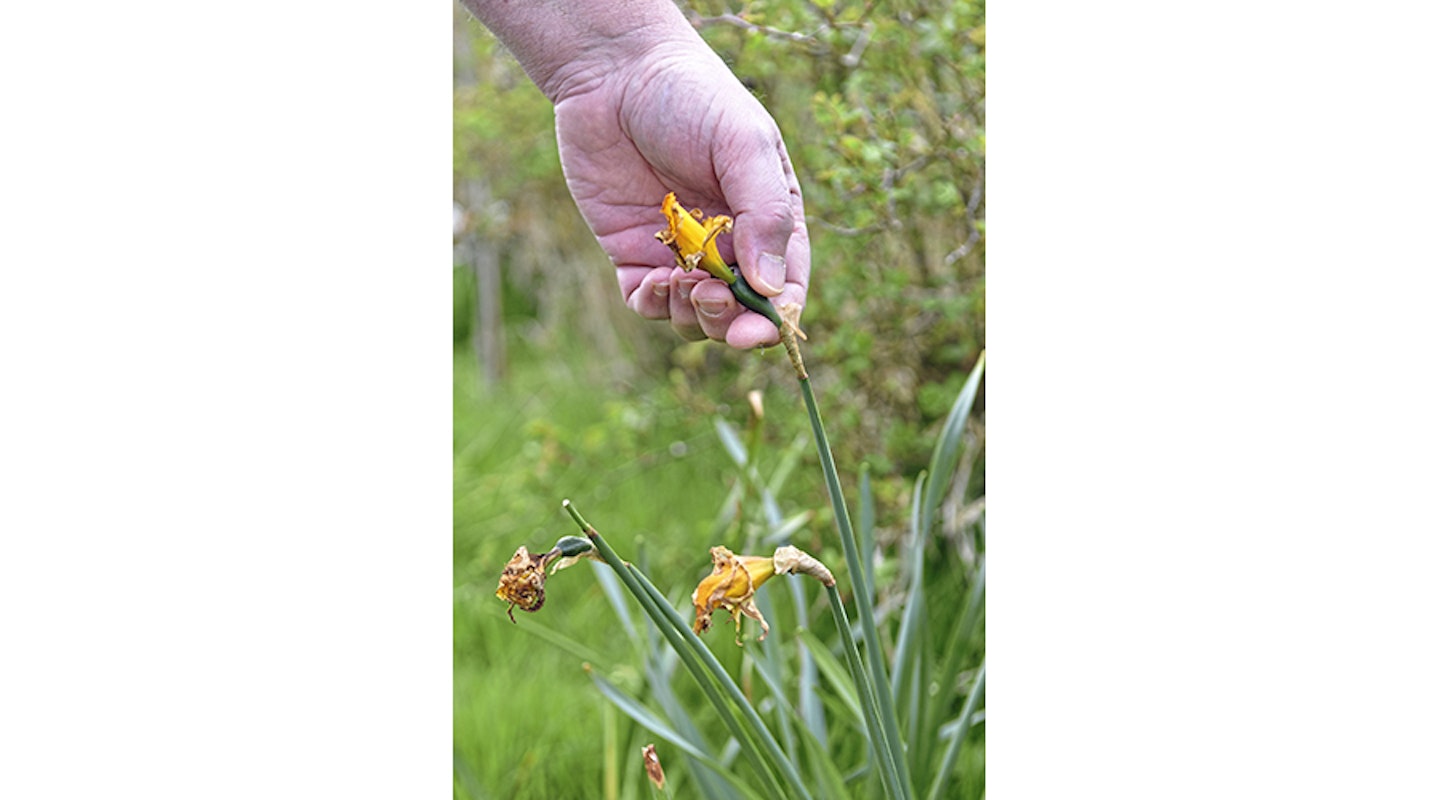
To help with this process, don’t tie up or cut off the withering foliage. Let the leaves die down naturally and only remove them when they begin to yellow. This helps the plant to store food in the bulb in order to produce flowers next spring.
If you want to move daffodils that you have grown in pots into your garden borders once they’ve finished flowering, wait until their foliage has died down. Once you’re satisfied the time is right, ensure you plant into the soil as deeply as you would if you were planting a bulb. Planting them too shallow can cause daffodils to stop flowering. Don’t be concerned that you might be burying some of the fading foliage. Finally, ensure that you water them in well.
Daffodil bulb planting FAQs
When is the best time to plant daffodil bulbs?
Plant the bulbs in late summer to early autumn – October is often recommended, while the soil is warm and moist.
Can I plant daffodil bulbs in spring?
If you miss the opportunity to plant bulbs in autumn, you can buy pots packed with spring bulbs ready to burst into flower from garden centres and supermarkets the length of the country.
And even if you did plant your daffodil bulbs in autumn, the proliferation of spring bulbs for sale in spring is all the excuse you’ll need to plant up some extra pots.
To get the most from your pot-grown bulbs, you’ll need to make sure that you buy them when the shoots are just emerging. Transfer them into a prettier plant pot than that in which they were grown, by carefully tipping the bulbs out of the container while keeping as much compost as possible around the roots. Make sure also that you plant the bulbs at the same depth as they were in their original pot.
What type of soil is best for daffodil bulbs?
They prefer a moist but well-drained soil.
Can I enjoy daffodils in winter?
It’s possible to plant daffodil bulbs in a shallow bowl on a sunny windowsill indoors and force them to flower early – in winter. This involves placing the bulbs shoulder to shoulder in bulb fibre or a gritty, well-draining peat-free compost, so their noses sit just above the rim. Put the pot in a cool, dark place (cupboard, modern garden shed or garage) for 12-15 weeks until the bulbs have begun to sprout. Effectively, you’re creating a false winter, which encourages the flowering stems and roots to develop before the leaves. Keep an eye on them, to make sure the bulb fibre/compost stays a little bit damp.
Small 4-5cm shoots will emerge during this chilling period, at which point you can move the pot into a bright, sunny position. Avoid the top of a radiator as this will dry out the compost. To get the timing right for Christmas flowers, start the bulbs off in late September.
Once your bulbs finish flowering, you can plant them out in a sunny, sheltered part of the garden to die back naturally and flower next year.
Paperwhite daffodil ‘Ziva’ or double ‘Erlicheer’ can take as little as four weeks to flower after planting indoors, without a chilling period. Follow the instructions on the packet for the best results.
How do I make cut daffodils last longer?
Hold the stems next to your vase to judge how much you need to trim away. Cut daffodil stems at an angle of 45° as sitting flat on the base of the vase reduces water uptake.
Daffodils contain sap that is poisonous to other plants. When you cut the stem you’ll see the base ooze. If you want to mix them with other flowers in a vase, trim the ends then soak them in water for a few hours. Change the water and then soak again. After a couple of hours, the stems should have stopped producing sap. You don’t need to bother with this if you’re just arranging daffodils in the same vase. Refresh the water in the vase every couple of days.
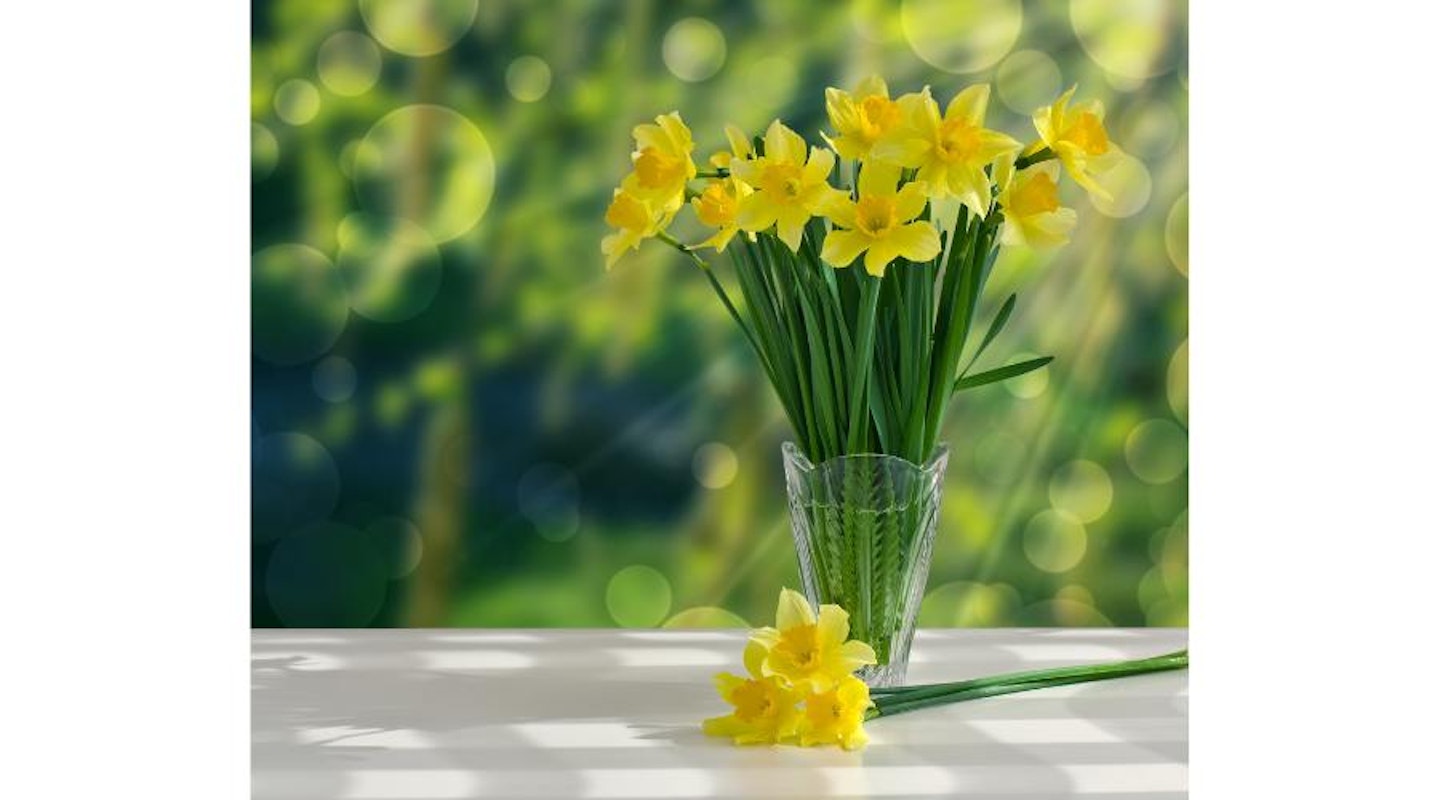
What to read next:
When to plant dahlias for timing perfection – according to gardening experts
Best trailing plants for hanging baskets to transform your garden 2024
Subscribe to Modern Gardens magazine and get the most out of your outdoor space. Discover everything you need to know to make your outside space look fantastic, quickly and easily, with hundreds of simple ideas, designer tricks, affordable products and expert advice in every issue of Modern Gardens. View our latest subscription offers to save on shop prices.
Angela Kenny is features and production editor for Modern Gardens magazine and is always on the look out for new and trending modern garden inspiration.
